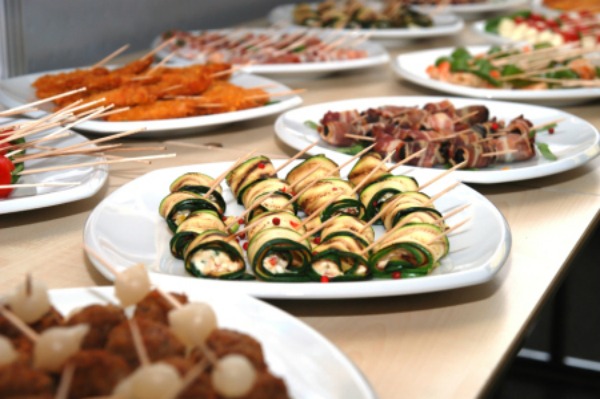You may think that eating is a simple, everyday event. But at a formal black-tie event, normal eating habits are cast aside and guests are supposed eat with ettiquette. Amongst the many rules of eating, appetizers also require special rules depending on what you are eating.
If caviar is passed to you in a bowl or crock with its own spoon, serve a teaspoonful onto your plate. Take small amounts of minced onion and sieved egg whites and yolks, as well as a few lemon slices from the small bowls of accompaniments that are going round. Assemble a canapé ( put what you have picked on a cracker or a small, thin piece of bread )to your taste with a knife, then use your fingers to lift it to your mouth.
If you’re at a reception where already prepared caviar canapés are being passed around to the guests on trays, simply lift one off (via the toothpicks that accompany each, if any) and pop it into your mouth.
Just Cheese
As an hors d’oeuvre, cheese is spread on a cracker with the knife that accompanies each kind.
When cheese is served with a salad, you can spread it on a cracker or a small bit of bread with a knife. A piece of cheese may be broken off and put on your plate with a fork and eaten with the served lettuce, if any. Soft, runny cheeses, such as Brie and Camembert, are always spread with a salad knife or butter knife.
Dessert cheeses served with fruit are easy to handle. Just cut the ripe apples or pears to a comfortable size, and then eat the cheese with a fork and the fruit with either a fork or your fingers. Take alternate bites of fruit and cheese at intervals.
Sipping Soups
Soup may be served either in a soup plate or in a cup, depending on the soup type and the degree of formality of the meal.
Clear soups are often served in small, doubled-handled consommé cups. A two-handled cream-soup bowl is larger than a consommé cup. You can test the heat of the soup with a spoon, then lift the cup to drink it. In any case, cooks and waiters for such formal dinners usually make sure that the temperature is suitable before releasing the soup to the table.
You can spoon and any vegetables or noodles left at the bottom and eat them. In both cases, when you are finished, place the spoon on the plate underneath and to the right of the cup; a signal that the waiter can carry it away. NEVER leave it standing in the cup.
When a soup plate is used, always spoon away from the table’s edge, lest you make a mess on the napkin. When you reach the bottom, you can tilt the plate slightly away from you and spoon as usual. Always sip from the side of the bowl of the spoon, and never put the whole of the latter into your mouth.
Tiny crackers or croutons (small crisp pieces of toasted or fried bread) may be added to your soup, whole, a few at a time. Larger crackers should be eaten separately unless you are having a hearty soup such as chowder, where you can add a few pieces at a time.
At all times, drink soups quietly.





